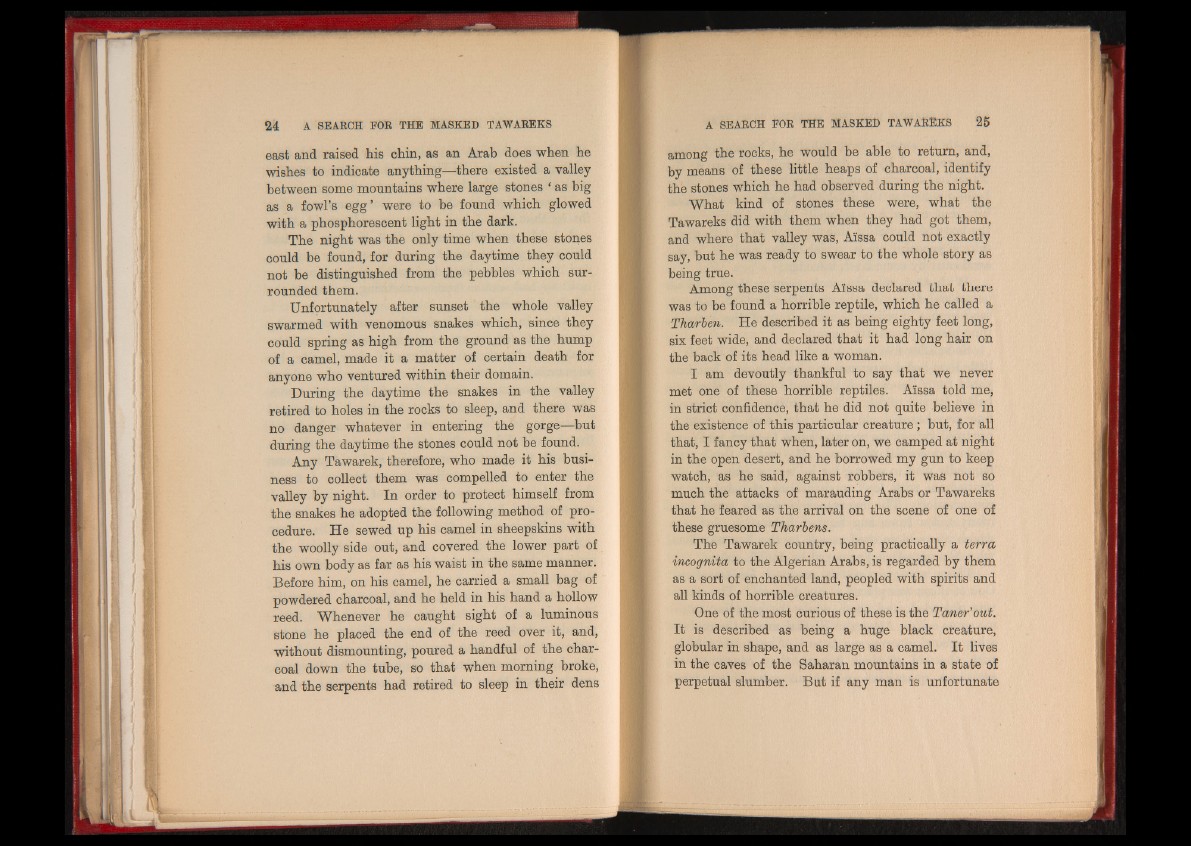
east and raised his chin, as an Arab does when he
wishes to indicate anything—there existed a valley
between some mountains where large stones ‘ as big
as a fowl’s egg’ were to he found which glowed
with a phosphorescent light in the dark.
The night was the only time when these stones
could be found, for during the daytime they could
not be distinguished from the pebbles which surrounded
them.
Unfortunately after sunset the whole valley
swarmed with venomous snakes which, since they
could spring as high from the ground as the hump
of a camel, made it a matter of certain death for
anyone who ventured within their domain.
During the daytime the snakes in the valley
retired to holes in the rocks to sleep, and there was
no danger whatever in entering the gorge—but
during the daytime the stones could not be found.
Any Tawarek, therefore, who made it his business
to collect them was compelled to enter the
valley by night. In order to protect himself from
the snakes he adopted the following method of procedure.
He sewed up his camel in sheepskins with
the woolly side out, and covered the lower part of
his own body as far as his waist in the same manner.
Before him, on his camel, he carried a small bag of
powdered charcoal, and he held in his hand a hollow
reed. Whenever he caught sight of a luminous
stone he placed the end of the reed over it, and,
without dismounting, poured a handful of the charcoal
down the tube, so that when morning broke,
and the serpents had retired to sleep in their dens
among the rocks, he would be able to return, and,
by means of these little heaps of charcoal, identify
the stones which he had observed during the night.
What kind of stones these were, what the
Tawareks did with them when they had got them,
and where that valley was, Aissa could not exactly
say, but he was ready to swear to the whole story as
being true.
Among these serpents Aissa declared that there
was to be found a horrible reptile, which he called a
Tharben. He described it as being eighty feet long,
six feet wide, and declared that it had long hair on
the back of its head like a woman.
I am devoutly thankful to say that we never
met one of these horrible reptiles. Aissa told me,
in strict confidence, that he did not quite believe in
the existence of this particular creature; but, for all
that, I fancy that when, later on, we camped at night
in the open desert, and he borrowed my gun to keep
watch, as he said, against robbers, it was not so
much the attacks of marauding Arabs or Tawareks
that he feared as the arrival on the scene of one of
these gruesome Tharbens.
The Tawarek country, being practically a terra
incognita to the Algerian Arabs, is regarded by them
as a sort of enchanted land, peopled with spirits and
all kinds of horrible creatures.
One of the most curious of these is the Taner’out.
It is described as being a huge black creature,
globular in shape, and as large as a camel. It lives
in the caves of the Saharan mountains in a state of
perpetual slumber. But if any man is unfortunate